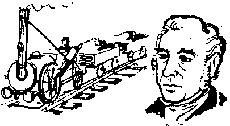George Stephenson
By Illa Vij
LONG ago, the fastest means of
transpo rt known to man was a galloping horse! On
September 9, 1781, a son was born to a humble colliery
fireman named Robert Stephenson, who lived in Wylam, near
New Castle. Robert was an uneducated man but with a great
imagination. This gift was passed on to his son George,
and it helped him become world famous. It’s strange
that George Stephenson did not invent the steam engine,
nor was he the first person to put a steam locomotive on
rails, yet the railway age began with him. rt known to man was a galloping horse! On
September 9, 1781, a son was born to a humble colliery
fireman named Robert Stephenson, who lived in Wylam, near
New Castle. Robert was an uneducated man but with a great
imagination. This gift was passed on to his son George,
and it helped him become world famous. It’s strange
that George Stephenson did not invent the steam engine,
nor was he the first person to put a steam locomotive on
rails, yet the railway age began with him.
George, as a child, did
not go to school. He was barely nine years old, when he
began earning the great sum of two pence a day, minding
cattle. He had enough time on his hands and his
imaginative mind worked at creating things. He made
whistles out of reeds, tiny models of mining engines out
of clay! By the time he was 12, he lead horses to pull
the plough.
He had become a strong lad
with a lot of determination to work. He possessed a
happy, generous nature and kept his mind open, ever ready
to learn. He was only 14 years old when he was appointed
assistant foreman in a colliery. He worked under his own
father. His immense interest in machines took him up the
ladder very fast.
Robert was 18, when he
joined a night school with an urge to read and write.
Along side, he worked as a mechanic. His main interest
lay in steam engines. At the age of 19, he felt happy and
proud that he could write his own name. During this time
Richard Trevithick, a Cornishman, invented the first
steam locomotive to run on rails. George heard of it and
saw it. He was determined to build a better one.
At Killingworth Colliery,
a new pumping engine had been installed, but it did not
work. Engineers tried to set it right but it remained out
of order. Stephenson studied the engine and felt that he
knew what was wrong with it. After gaining permission to
work on it, he set it right in four days. The owners were
so delighted that he was awarded £ 10 and a holiday, the
first in his life. With his first success, everyone at
the colliery began respecting him. The owners
respectfully co-operated with him, when he declared that
he could construct a new kind of locomotive.
He was provided with the
material and the manpower required. It took him 10 months
to complete his first locomotive. George
Stephenson’s locomotive was a wheezing contraption
which moved in a series of jerks and jolts. It moved at
about 40 miles an hour and it was the first locomotive in
the world to run with smooth wheels on edge rails. The
self-taught inventor was only 33 years old then. He built
better and bigger locomotives also designed to haul coal
from the pits. He dreamt of long railway lines with
locomotives carrying men and material.
In 1821, at the age of 40,
George Stephenson left the collieries to build a railway
line between Stockton and Darlington. Four years later,
he drove a locomotive along the 10-mile stretch, drawing
a train of 38 engines loaded with 600 passengers, coal
and flour. The railway age had been initiated.
The merchants of other
cities like Liverpool and Manchester wanted their cities
to be linked by railway. Stephenson began his work, but
there was a lot of opposition from the canal companies
because their business seemed to be threatened. They
tried their best to stop him.
He was attacked by mobs
and bulls, equipment was destroyed and sermons were
preached against railways in some of the churches.
Battles took place in Parliament too. The argument was
that locomotive would frighten their animals, smoke would
poison the air, buildings along the railway line would
catch fire, horse breeding would suffer, hay and oats
would not be sold and the nation’s iron reserves
would be exhausted. Harness makers and coachmen also
raised their voice against the railway.
Hence, Parliament refused
to give permission to set up railway. But Stephenson did
not give up. With the support of Prof William Huskisson,
M.P. for Liverpool, he won the battle. The line was
opened on October 6, 1829. Stephenson was at the
footplate and the Prime Minister in the carriage behind
him. Unfortunately, Huskisson was accidentally knocked
down by one of the locomotives. Since no doctor was
around, Stephenson rushed him to Manchester at an
extraordinary speed of 36 m.p.h. The speed was
extraordinary because in those days this speed was
unheard of. Huskisson died, but the railway that he had
supported had proved itself.
After this success,
Stephenson’s services were in great demand and
thereafter he never looked back. He became rich but
success, fame and money never made him a snob. He always
remained cheerful, helpful and kind. On August 12, 1848,
he died in his home on the hill above Chesterfield.
|

